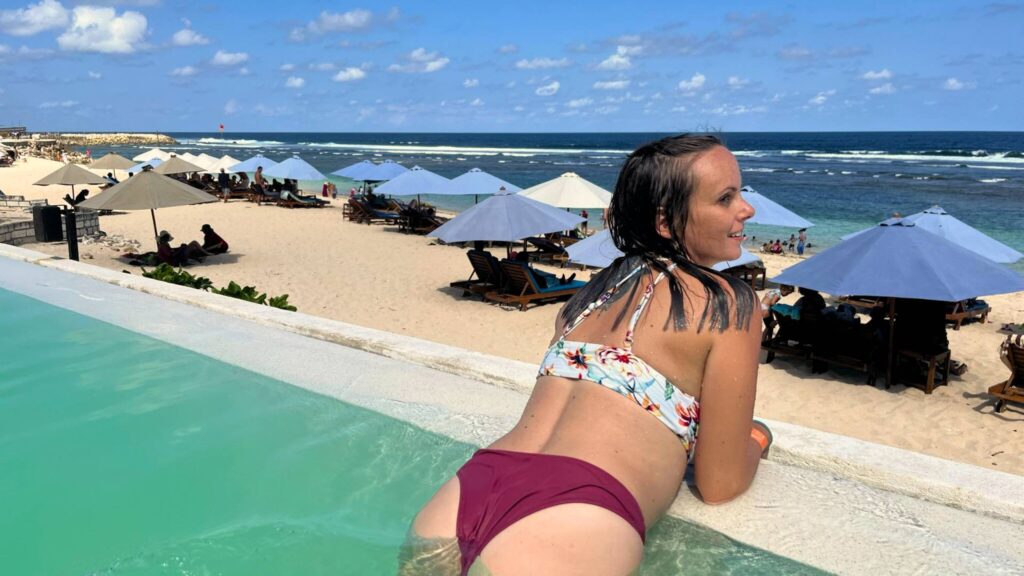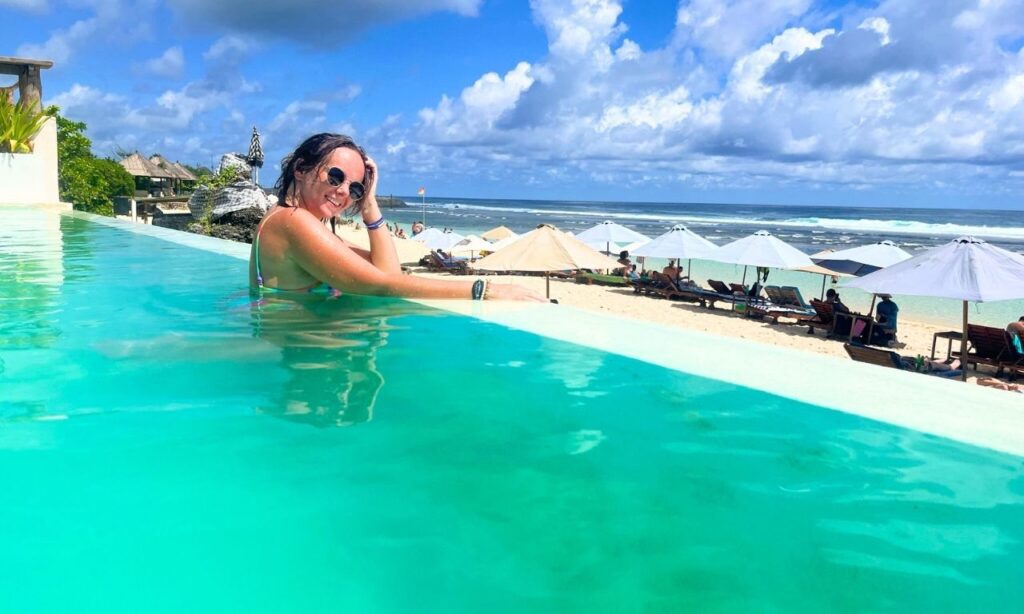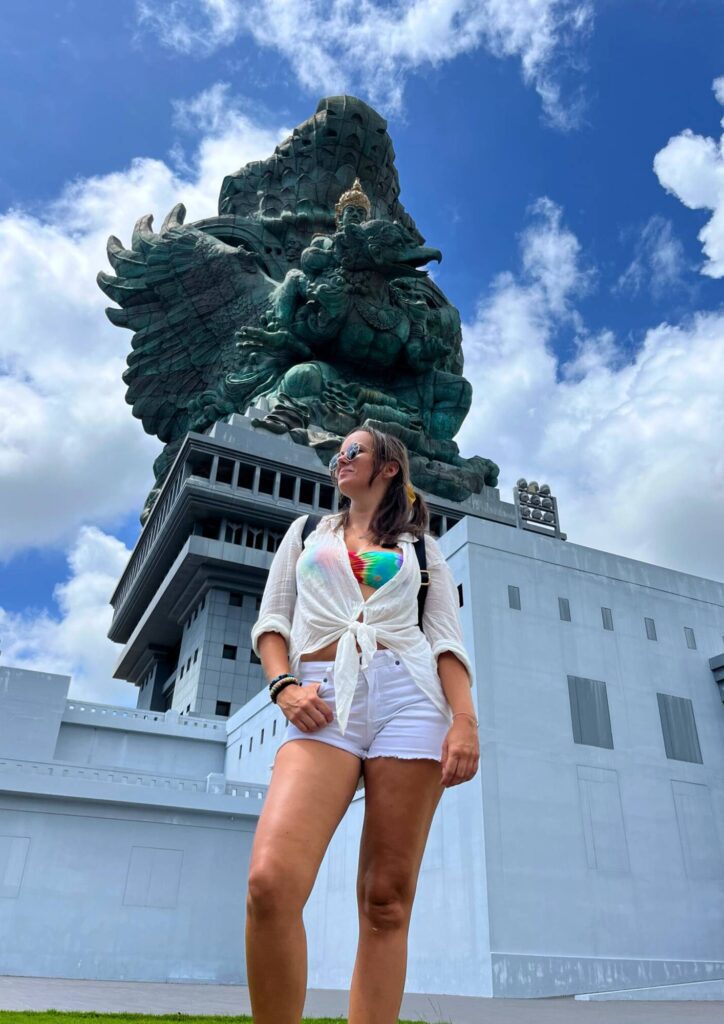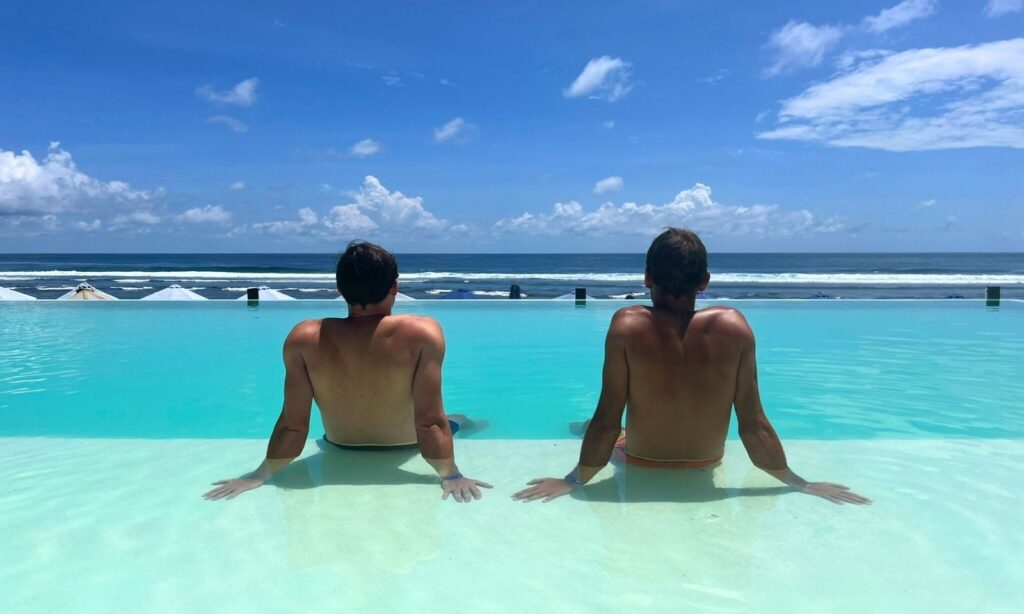
The first time we reached Uluwatu we felt the island exhale. Traffic thinned, cliffs rose, and the water stretched out in endless shades of blue. This is not Bali’s busiest corner but it is one of its most beautiful.
Here you can swim in clear coves like Melasti and Thomas, climb the temple path for the Kecak fire dance, or stay in cliff villas where sunrise feels private. What follows is our honest guide to Uluwatu in 2025, shaped by mornings on scooters, afternoons on beaches, and evenings watching the sky turn violet.
💡 Tip: ✈️ Planning a bigger Bali adventure? Before diving into Uluwatu, don’t miss our Complete Bali Travel Guide – Packed with tips on visas, regions, transportation, and hidden gems all over the island.
When we first started exploring Uluwatu, we kept jumping between beaches and cliffside cafés without really knowing how close everything was. That’s why we made this interactive map 🗺️.
It shows all our favorite spots – from sunset temples to vegan smoothie cafés. Save it on your phone and you’ll never get lost on the Bukit peninsula.
Getting to Uluwatu
We first came here on our own scooter. The ride south felt like a slow reveal. At first just traffic and shopfronts, then the hills rose and the air turned lighter, and finally the ocean appeared below the cliffs.
On a quiet day it takes 45 to 60 from the airport, from Seminyak, or from Canggu. In the afternoon between 2 and 6 pm it can easily stretch to 90 minutes. Trucks stall on the climbs, and when rain falls after dark the surface shines, becomes and feels slippery.
If you do not want to ride yourself you still have options. Grab and Gojek both offer cars for a fixed price. They also have motorbike taxis that can take you straight from Canggu to Uluwatu. Many people ride down in the morning, spend six or seven hours at the beaches and temple, and then book another car or bike back north. It is simple and flexible.
And then there is the new water route, which many are curious about. GoBoat connects Nelayan Beach in Canggu with Padang Padang in Uluwatu. The crossing takes about thirty five to forty minutes on the water and tickets start from 255k rupiah for a one way seat. Departures run in fixed windows, the schedule depends on weather, and seats often sell out, so booking ahead is smart. Arrive 20 to 30 minutes early, bring a dry bag, and expect a beach landing on both sides – shoes off, feet in the water, and your bag safe from the waves. On a calm day it is the fastest and most scenic way. You skip the traffic and arrive directly on the sand.
Want to skip Bali’s traffic between Canggu and Uluwatu? The GoBoat shuttle takes you straight across the water in about 40 minutes. Here are the key facts you should know before booking.
• Canggu → Uluwatu: Nelayan Beach to Padang Padang
• Uluwatu → Canggu: Padang Padang to Nelayan Beach
• Boarding is directly on the sand → dry bag essential
• Padang Padang entry fee: IDR 15,000 (foreign adult)
• Crossing time: 35–40 minutes
• Fixed daily departure windows (about every 2 hours)
• Morning & afternoon slots in both directions
• Arrive 15–30 minutes early to check in
• Standard: IDR 255,000 – no changes, no refunds
• Flexible: IDR 255,000+ – one free change up to 1h before departure, refund if operator cancels
• + Surfboard: add-on per passenger, one board allowed
• Children 0–12: must travel with an adult on the same ticket type
Book on the official GoBoat site
Good to Know
- No suitcases – only one backpack/handbag per person
- Open boat: valuables may get wet → waterproof case recommended
- Trips may be cancelled in rough seas – flexible ticket gives you a refund or voucher
- Operator cancellations: voucher valid for 12 months (standard), or refund/voucher (flexible)
🔎 Accuracy note: Info verified Sep 2025. Always confirm departure times & weather updates at GoBoat.id.
Getting around Uluwatu
Once you arrive, the peninsula has its own rhythm. For us the scooter was the easiest way to feel part of it. At first the traffic seems chaotic with left side driving, horns, and dogs darting across the road. By the third day it feels natural and you glide down the hills with the sea ahead. Rentals cost about 60 to 80 thousand rupiah per day. Always check the brakes and lights, ask for two helmets, and take photos of scratches before you leave. We keep a thin rain jacket and a dry bag under the seat.
Ride hailing apps
like Grab and Gojek work mostly well here. Drop offs are easy almost everywhere. For pickups you sometimes have to walk a little to a clear spot where drivers are allowed. After the Kecak show it is not worth walking all the way to the main road. The parking area outside the temple is already full of cars and taxis, and it is simpler to meet your Grab or Gojek there.
Tip: For temple evenings or beach pickups, order your ride a little earlier or walk to a main road for easier pickup.
Private drivers
are another good option. They are especially useful for evenings out, rainy nights, or full day trips when you want to explore without thinking about parking or helmets. Families often find this easier than scooters, and prices are fair for a whole day with fuel included.
Night rain plus steep hills can be dangerous. If you are new to scooters, enjoy the day and return with a driver after sunset.
From IDR 60–80k/day. Freedom to explore, but tricky at night rain. Helmets and dry bag essential.
IDR 600k–700k per day (8–10h, incl. fuel). Best for families, rain, or after sunset.
Reliable for drop-offs. Pickups at beaches/temple may require a short walk to the main road.
Cheap and quick for solo rides. Great for same-day returns Canggu ⇄ Uluwatu.
Best places to Stay in Uluwatu
Uluwatu does not feel like a single town. It is more a string of small villages stretched along the cliffs, each with its own rhythm. Bingin is a maze of steps that leads you down to the beach, where grilled fish is served at sunset and the ocean feels close. Around Suluban you stay near the temple and the famous Single Fin, which makes evenings walkable and lively. Farther east, Ungasan and Melasti are calmer and perfect if you are dreaming of turquoise swimming water and quiet nights.
🌊 Pecatu — The Beating Heart
This is the lively center of Uluwatu, close to Padang Padang and Bingin, with temples, surf spots, and clifftop views. Staying here means you are in the middle of the action, with cafés, warungs, and easy access to multiple beaches.
Where to stay in Pecatu:
- Mid-range: Radisson Blu Uluwatu — Spacious rooms, pool, and sunrise yoga. ~€110–220/night.
- Boutique: PinkCoco Uluwatu (Adults-only, near Padang Padang) — Fun vibe, walkable to the beach. ~€100–160/night.
🏝️ Ungasan — Luxury & Seclusion
South of Pecatu, Ungasan is quieter, more private, and home to Bali’s most luxurious cliff resorts. This is where you come for once-in-a-lifetime views, infinity pools, and private beaches.
Where to stay in Ungasan:
- Luxury: The Ungasan Clifftop Resort — Villas with private stairs down to the sand. ~€520–900+/night.
- or: Karma Kandara — Infinity pools, spa, private beach access. ~€400–700/night.
- Iconic: The Edge — Iconic oneeighty° sky pool, plus day experiences. ~€1,000+/night.
- Design Icon: Alila Villas Uluwatu — Minimalist architecture, absolute privacy. ~€700–1,200/night.
🏖️ Pandawa — Calm & Family-Friendly
On the eastern edge, Pandawa Beach is one of Bali’s most swimmable bays. Calm water makes it perfect for families, with kayaking and paddle boarding available. Limestone cliffs frame the scene, and there’s a mix of stays from high-end resorts to smaller inns.
Where to stay in Pandawa:
- Luxury: Hilton Bali Resort (Nusa Dua/Pandawa side) — Big family resort with clifftop pools. ~€220–400/night.
- Budget: Guesthouses near the beach, often ~€25–50/night.
🌅 Bingin — Surf & Boho Charm
Bingin is a cliffside village reached by steep stairs, with beach warungs, surf breaks, and tide pools. The vibe is barefoot and bohemian. You’ll find digital nomads, surfers, and sunset seekers gathering here.
Where to stay in Bingin:
- Boho Boutique: Mu Boutique Resort — Cliff bungalows with ocean views. ~€180–350/night.
- Budget: Mule Malu Tropical Stay — Calm and cozy, a lovely base. ~€45–90/night.
- Budget: Bombora Surf Camp — Social, fun, and great for surf lessons. ~€25–50/night.
🌿 Balangan — Rustic Escape
Balangan is a quieter, rustic beach on the western Bukit. Surfers and photographers love it for its dramatic cliff views and laid-back vibe. There’s less development here, which makes it a true escape.
Where to stay in Balangan:
- Budget: Simple beach huts or homestays from ~€20–40/night.
- Mid-range: Small eco-resorts tucked into the hills, often ~€70–120/night.
🍤 Jimbaran — Just Beyond Uluwatu
Not technically in Uluwatu, but just north, Jimbaran is famous for seafood dinners on the sand and its calm bay. Upscale resorts line the beach, making it a convenient choice for families and honeymooners alike.
Where to stay in Jimbaran:
- Luxury: InterContinental Bali — Classic beachfront resort. ~€300–500/night. some of the best in Bali.
- Luxury: Four Seasons Jimbaran — Villas with plunge pools, world-class service. ~€700+/night.
Choosing the Right Spot
Each area offers something unique, from luxury to seclusion and surf spots. When selecting accommodation, consider your priorities – whether it’s proximity to the beach, access to cultural sites, or escaping the crowds. A quick map check can ensure you choose the perfect location for your Bali experience.
✨ Bali Travel Guide 2025 ✨
Planning your trip to Bali? Our brand-new 2025 PDF Guide (€12) gives you everything you need:
insider tips, maps, hidden gems, and ready-to-use itineraries.
Written by us, Ellis & Mario, after spending months living across Bali.
Honest. Practical. No fluff. Just the stuff that works in 2025.
Exploring Uluwatu: Beaches, Cliffs, and Hidden Gems
The beaches on the Bukit Peninsula are the reason many people fall in love with Uluwatu. Some are calm enough for swimming, others are pure surf breaks, and almost all require a climb down steep stairs that makes the first glimpse of turquoise water even more rewarding. Mornings are usually the calmest for swimming, while evenings bring the golden light that makes the cliffs glow. Always check the flags, listen to lifeguards when they are present, and know your own limits.
White sand, turquoise lagoon, one of the safest for swimming. Easy road access, good for families.
Calm bay with space to swim or kayak. Family-friendly and organized facilities.
Small scenic cove, swimmable at calm tide. Outer reef is a famous surf break.
Cliffside surf beach, not great for casual swimming. Warungs on the sand, magical sunset vibe.
Dramatic cliffs and photo points. Better for surfers and sunset views than swimming.
Long stretch of sand, calmer swimming when tide allows. Access via steep stairs.
Remote, wild, and quiet. Long steep access. Beautiful but strong currents.
Hidden cove with tide pools and sea caves. Steep stairs, currents beyond the pools.
Melasti
Our go-to when we wanted a real swim. The road curves all the way down to the sand, parking is simple, and the lagoon is calm at the right tide. White sand, turquoise water, and a holiday mood that makes hours slip by. Watch for reef patches at low tide and a heavier shorebreak when swell is up.

Pandawa
Wide bays, easy access, plenty of facilities. Families love it here because the water is calmest in the mornings and there is space to spread out. Not the most intimate beach, but reliable when you want simple swimming.
Padang Padang
A small cove reached through a narrow rock gate. The inner bay is gentle enough for a swim around mid tide, while the outer reef is a world-class surf break only for experienced riders. Early morning is magical before the crowds arrive.
Thomas Beach
A long staircase keeps this place quieter. The sand is soft, the cafés are simple, and on kind days the water is calm enough to float for hours. It feels like the relaxed cousin of Padang Padang.
Bingin
A village of steps that lead down to one of the most consistent reef breaks on the Bukit. Surfers thrive here, but swimming is not safe. Evenings are special though: the beach fills with grilled fish warungs and the light turns pink.
Balangan
Golden sand stretched below a cliff with iconic viewpoints above. The surf is strong, the waves peel long, and sunsets on the headland are unforgettable. Swimming is not advised, but it is a classic spot for photos and atmosphere.
Dreamland
Easier access than many, with parking just above the beach. The waves can be heavy, but the light at sunset is beautiful and lifeguards are sometimes present. Swimming only if the flags allow.
Nunggalan & Nyang Nyang
Wild, open, and usually empty except for a few other souls. The paths down are steep and long, which keeps them quiet. The ocean here is powerful, currents are strong, and you should not swim. Come for solitude, sunrise walks, and the feeling of Bali before development.
Green Bowl
A pocket of turquoise water reached by very steep stairs. At low tide tide-pools appear that are safe to explore. Beyond them the currents are strong and only for surfers. Sea caves and sunlight make it a striking little bay.
Water Safety
Though Uluwatu’s beaches are stunning, it’s important to be aware of water safety. Many of the beaches, like Padang Padang and Dreamland, are known for their strong currents and riptides, making them ideal for surfers but challenging for swimmers. If you plan to swim, check the local conditions beforehand and stick to safer areas like Melasti Beach and Pandawa Beach, which are more suitable for swimming due to their calmer waters.
Top Things to Do in Uluwatu: Beyond the Beaches
While Uluwatu is famous for its breathtaking beaches, there is more to discover beyond the sand and surf. From age-old temples to bustling beach clubs, this idyllic haven offers many distinctive experiences for travellers of all kinds. You can visit Uluwatu also if you want deep cultural dives, party to the best DJ´s in the world or just want to chill in a café away from the noise.
1. Visit Uluwatu Temple and watch the Kecak Dance
Just before sunset we walked the cliff path above the ocean. The light shifted to deep orange and as the chanting started we both felt it. Not dramatic, just a quiet intensity. The Kecak performance is not flashy. It is raw, rhythmic and a little surreal. Dozens of voices rising together, the fire in the center, the sea behind it all. We let our driver sort out the tickets while we wandered the temple. After the show it was easy to catch our Driver in the parking area.
IDR 50,000 (adult), IDR 30,000 (child) – includes sarong & sash
Ticket: IDR 150,000 per person
Usually 18:00 & 19:00 – arrive 30–60 min early for seats
Bring a water bottle and a small cushion; monkeys roam the cliffs
When visiting temples like Uluwatu Temple, it’s crucial to follow the dress code to show respect for Balinese culture. Visitors are required to wear a sarong and/or sash, which are typically available at the temple entrance (in this case they will be provided without any additional charge). Be sure your shoulders and knees are covered before entering. Also, remember to avoid stepping on sacred areas or pointing your feet at shrines, as these are considered disrespectful.
2. Visit GWK Cultural Park
We visited shortly after the G20 summit. The plazas were wide and quiet, and it was easy to imagine world leaders walking across those massive stone tiles. The Garuda Wisnu Kencana statue is one of the tallest monuments in the world – over 120 meters high – showing the god Vishnu riding the mythical bird Garuda. You can spot it from the airplane when flying into Bali. The whole site felt ceremonial, not like a theme park, but like a cultural landmark that connects tradition with modern Bali.
IDR 150,000 (tourist), plus optional shuttle: IDR 40,000
Typically 09:00–20:00; cultural performances throughout the day
Plan 1.5–2.5 hours for a relaxed visit
Garuda Wisnu Kencana statue can be seen from the air; located in Ungasan
Bring a cap and water — there’s little natural shade on the large plazas

3. Pay A Visit To Uluwatu Beach Clubs
Palmilla was our choice when we wanted a livelier afternoon. It sits directly on the sand at Melasti, with pools, music, and plenty of energy. For us it was less about swimming and more about enjoying the scene with a drink in hand while the cliffs framed the horizon. Weekdays felt calmer, weekends were busy and loud.
~IDR 100,000
~IDR 1,000,000+ for premium beds
08:00–20:00 (Fri–Sun often until 21:00)
Always check their latest Instagram stories for event info

Melasti Beach
This was our true favorite. The road winds all the way down to the sand, parking is simple, and stairs
lead directly onto soft white beach. At the right tide the lagoon feels like a natural swimming pool, safe
and turquoise. We often spent whole mornings here and lost track of time completely.
Easy road, large parking, only a few stairs
Lagoon swimmable at calm tide, clear turquoise water
Sometimes present on the main stretch
Morning: calmest for swimming • Late: great sunset light
Reef visible at low tide; strong shorebreak when swell is up
The Edge – Day Experience
One morning we treated ourselves to the Day Experience at The Edge, and even though the weather was not perfect, it felt unforgettable. We had a floating breakfast in the sky pool with the cliffs dropping away below us, followed by a ninety-minute massage that left us weightless. The view stretched endlessly over the ocean, dramatic even under grey skies. It felt like a once-in-a-lifetime treat, the kind of memory you carry long after the holiday ends.
Floating breakfast + 90-min couple massage + pool access
IDR 2.5M – 3.5M+ per couple (book ahead)
Morning and midday slots available
Sky pool with dramatic cliff view, limited capacity
Required via official site or hotel concierge
Beji Guwang Hidden Canyon
We didn’t discover this canyon right in Uluwatu, but rather on the way south. It is carved by water and shaded by jungle, a place where you wade through streams and scramble over rocks with a local guide. It is not a quick stop, more a mini adventure, and it makes sense to combine it either on your drive to Uluwatu or when leaving the peninsula. For us it felt different from the beaches – wet, raw, and full of energy.
~IDR 200,000–300,000 per person (with guide)
~08:30–16:30
Expect wading, scrambling • Moderate fitness needed
Avoid after heavy rain • May close for safety
Beji Guwang village • 45–60 min north of Uluwatu • Ideal stop en route
Savaya Dayclub
Savaya is Uluwatu’s cliff-edge megaclub, more festival stage than beach bar. It draws international DJs and a premium crowd, with views that stretch endlessly over the ocean. The vibe is high-energy and best if you want a full day or night of music and spectacle.
Prices vary by event • Often IDR 300k–1M+
Premium drinks & food • Table packages available
Usually 13:00–22:00 • Later on event nights
Ride-hailing after closing is slow • Pre-book a driver if possible
Uluwatu Cliff Views
The headlands around Uluwatu are dotted with small tracks that open up to sweeping ocean views. At golden hour the cliffs glow and locals gather with cameras or just to sit quietly. They are free to access but require careful footing.
Free access • Small parking fees (IDR 5k–10k)
Sunset is magical • Mornings quiet but bright
No safety rails • Keep distance from cliff edges
Food in Uluwatu
Eating in Uluwatu feels slower and more limited than in Canggu, but that is not a weakness. It suits the
cliffs and the beaches, where days move differently.
There are smoothie bowls and good coffee, of course, and you will find healthy cafés tucked into side roads, but the choice is smaller. In 2025 new cafés and boutique hotels are opening one after another, and it is easy to imagine that in a few years Uluwatu will stand on the same level as Canggu when it comes to food variety. For now it is less about chasing the next restaurant and more about enjoying what is near your beach or your stay.
For a special evening many travelers head to Jimbaran, which technically sits just north of Uluwatu but feels like part of the same journey. Long rows of tables stretch directly across the sand, candles flicker as the tide pulls back, and the sky deepens into violet while fishing boats appear on the horizon.
The food itself is nothing to rave about – menus are nearly identical, and when we went our dishes arrived lukewarm. It is very much a tourist setup, popular with Indonesian holidaymakers as well. Yet the setting is unforgettable. If you come knowing that the highlight is not the cuisine but the atmosphere, you will find it worth it. Sitting barefoot in the sand with waves rolling in beside you is a memory that lasts longer than the taste of the meal.
Nightlife in Uluwatu
We are not nightlife people ourselves, so we can only share what friends and fellow travelers told us.
Still, it is clear that Uluwatu has become one of the nightlife centers of Bali. The setting alone – clubs built directly on the cliffs with the ocean stretching below – makes going out here feel special. The best-known is Savaya, a megaclub that brings some of the world’s most famous DJs to its stage. Parties here feel more like festivals, with world-class production, huge crowds, and premium prices to match. It is the place to go if you want to dance under the stars until late, but do not expect budget
evenings.
Beyond Savaya, there are smaller cliff bars and beach clubs that transform into party spots after sunset. Around Bingin and Suluban you will find bars with live music, fire shows, and sunset cocktails that slide easily into dancing as the night deepens. For party travelers Uluwatu is one of Bali’s top destinations, while those looking for quiet evenings will be happier in cafés or at beach dinners.
How much does traveling uluwatu cost
Traveling Uluwatu can be as simple or as lavish as you want it to be. A scooter, a homestay, and grilled fish on the sand make it one of the most affordable beach destinations in Bali, but the cliffs also hide some of the most exclusive resorts on the island. Knowing what to expect helps to plan calmly and enjoy more.
Costs at a glance (per person)
Costs at a Glance
Per person unless noted.| Category | Budget | Mid-range | Luxury |
|---|---|---|---|
| Stay (per night) | €12–30 | €50–120 | €180–500+ |
| Food (per day) | €8–15 | €20–35 | €60–120 |
| Transport | €5–8 scooter | €15–35 rides | €40–80 driver |
| Activities | €0–10 | €15–40 | €60–120+ |
Currency reference (Sep 2025): €1 ≈ IDR 19,100 · US$1 ≈ IDR 16,400.
Best time to visit Uluwatu
Uluwatu has two moods. From April to October the cliffs glow in dry light, the surfis strong, and mornings often bring calm lagoons for swimming. July and August are the busiest, with surfers and summer crowds filling the roads. The shoulder months in April to June and September to October are a sweet spot – calmer seas, good weather, and fewer people.
From November to March rain clouds sweep in and the skies turn dramatic. Beaches are quieter, the cliffs feel wilder, and the water can be rough. It is not the season for every traveler, but for those who like space and atmosphere, the rainy months carry their own charm.
Month by month in Uluwatu
- Jan–Feb
- Lush green cliffs, heavy showers possible, seas rougher. Best for solitude, photography, and dramatic skies.
- Mar
- End of rainy season, some calm days sneak in, still fewer visitors.
- Apr
- Shoulder month, sunny days return, seas more reliable. Great balance of weather and space.
- May
- Sweet spot, turquoise lagoons, calmer mornings, fewer crowds.
- Jun
- Dry, bright, great for surf and day trips, not yet peak.
- Jul–Aug
- Peak season. Surf culture alive, sunsets crowded, roads busy. Book stays and drivers early.
- Sep
- Golden light, reliable weather, fewer crowds than high summer.
- Oct
- Warm, sometimes humid, first rains appear, still good for beach days.
- Nov–Dec
- Rainy season begins. Quiet beaches, cheaper stays, dramatic afternoon skies.
Mini Itinerarie: 24 hours in Uluwatu
Begin your day at Padang Padang Beach, a small cove where you can swim when the tide is right. It is
compact and easy to reach, which makes it perfect for a short visit. From there continue towards Bingin
for lunch in one of the cafés above the beach or a few hours relaxing on the sand. In the late afternoon,
head south to Uluwatu Temple. Walk the cliff path before sunset, then take your seat for the Kecak
fire dance, when the chanting and the sky seem to merge into one unforgettable scene. After the show,
dinner in Bingin or Jimbaran rounds out the day.
On your second day, start with Thomas Beach in the morning. The stairs keep it quieter, and the light is
soft while the tide is still calm. After a swim, head north to Dreamland Beach, larger and livelier, with
rolling surf and plenty of space to stretch out.
Continue just a little further to Balangan Beach, where you can walk up to the famous cliff viewpoint
for photos before stepping down to the sand for a simple warung lunch.
In the afternoon drive south towards Melasti Beach, one of the most swimmable spots on the Bukit.
The wide lagoon and tall cliffs make it a beautiful place to end the day. Stay for golden hour, when the
light on the limestone cliffs feels almost cinematic.
FAQs (Quick Answers)
Can you swim in Uluwatu?
Yes, but not everywhere. The safest bays are Melasti, Pandawa, Thomas and parts of Padang Padang when the tide is calm. Other beaches are surf-first with strong currents or reefs. Always check the flags and tides before going in.
What time is the Uluwatu Kecak Fire Dance?
There are usually two evening shows, one around 18:00 and one around 19:00, depending on the season. Arrive 30–60 minutes early if you want a good seat, especially for the sunset slot.
Which month is best to visit Uluwatu?
The sweet spots are April to June and September to October, when the seas are calmer, the weather is dry, and the crowds are smaller. July and August are peak surf season and very busy, while November to March brings rain and dramatic skies.
How do you get from Canggu to Uluwatu?
By road it takes 45–90 minutes depending on traffic. For something different, there is now the GoBoat shuttle (Nelayan in Canggu ⇄ Padang Padang in Uluwatu), which takes about 35–40 minutes on water. It is weather dependent and has fixed departures.
Is Grab or Gojek allowed at Uluwatu Temple?
Yes for drop-offs, but pickups inside the temple or at beach coves are often restricted. The trick is to walk five to ten minutes to the nearest main road and order from there, or pre-arrange a driver for after the show.
How expensive is Uluwatu compared to the rest of Bali?
Accommodation and beach clubs are slightly higher than in Canggu or Ubud. Budget travelers can still manage on €35–50 a day, while mid-range stays and meals run around €80–150 a day. Luxury cliff resorts easily pass €200 a night.
Is Uluwatu safe at night?
Yes, but scooter riding after dark, especially in the rain, can be dangerous because of steep hills and slippery roads. If in doubt, book a driver for the return trip after sunset.
Is Uluwatu worth it for non-surfers?
Absolutely. Uluwatu is known for world-class surf, but the swimmable beaches, the temple, and the sunsets on the cliffs make it one of Bali’s most rewarding areas even if you never touch a board.
Conclusion: Uluwatu – The Ultimate Blend of Adventure, Relaxation, and Culture
Uluwatu is one of Bali’s most sought-after destinations. It offers a perfect mix of adventure, relaxation, and Balinese culture. From world-class surfing spots and pristine beaches like Padang Padang and Dreamland to sacred sites such as the iconic Uluwatu Temple, there’s something for every type of traveler. Whether you’re seeking exhilarating activities like surfing or simply want to relax at one of Uluwatu’s luxury beach clubs, this destination will captivate your senses.
Make sure to explore the hidden gems of Uluwatu, enjoy the breathtaking sunsets, and plan visits to the area’s renowned cafés and beach bars. Just remember, Uluwatu is a bit more remote than other areas of Bali, so transportation and preparation are essential. With a laid-back vibe and limited nightlife, Uluwatu is ideal for those looking to experience a more tranquil side of Bali.
If you found this Uluwatu travel guide helpful, don’t forget to share it with fellow travelers. Enjoy the magic of Uluwatu and make unforgettable memories in Bali’s stunning cliffside paradise!





